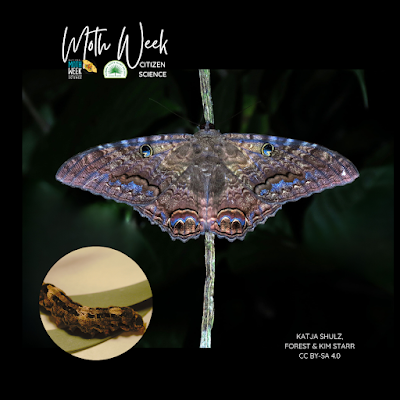National Moth Week 2023 - The Black Witch Moth
Ascalapha odorata, commonly known as the black witch, is of special significance to the author. A large bat-shaped, dark-colored nocturnal moth, the black witch ranges from the southern United States to Brazil. It is the largest night owl moth, or owlet moth, in the country. The black witch is more common in South Florida than other parts of the United States- chiefly because it favors tropical climates which makes sightings in the U.S. and Canada a rare treat. Adults are capable of flying great distances. They are known to be blown far north, away from their natural range, during severe weather events.
The black witch is a frugivore- a lover of sugar-rich fruit. Adults of Ascalapha odorata feed on overripe rainforest fruit, especially bananas, and larvae consume tender, new leaves of plants. Most of its host plants are legumes (polyphagous on numerous Fabaceae species). It favors Acacia species, Kentucky coffeetree (Gymnocladus dioicus) and Locust trees (Robinia sp.) in summers, and Bird of Paradise shrub species (Caesalpinia sp.) and Candlestick tree (Senna alata) year round in its neotropical range
Female moths can attain a wingspan of 24 centimeters, while males are somewhat smaller, reaching 12 centimeters. Adult females are easy to identify as they have a pearlescent white stripe that runs across their wings (submarginal band). These moths are particularly beautiful under ultraviolet light with parts of their wings fluoresce in indigo and other jewel tones.
The eggs of Ascalapha odorata are incredibly small (about 2mm), round and gray. They hatch within 4-5 days in ambient temperatures of 25C (77F) or more. Larvae have brown and black colorations and in addition to being excellent animal defecation camouflage, they are nocturnal and descend to the ground to hide in leaf litter during the day. If high in the canopy, they choose to press against the bark only to resume herbivory after dusk. There are five instars. The caterpillar develops its prolegs (a fleshy, stubby structure that functions as leg-like appendages) at its third instar. Larvae pupate into dark brown to black cocoons on the ground, covered by leaf litter.
On an esoteric note, the black witch harkens omens of fortune or misfortune (depending on the folklore). The author witnessed his first and only black witch (a male) perched by his window for two days. This owl moth sighting coincided with a breeding pair of barred owls continually training their juvenile in his yard around the time when his term as Florida Native Plant Society President began.
"Discover beauty beyond butterflies"- Mark Kateli
Come celebrate moth awareness week collaboratively with National Moth Week and Florida Native Plant Society. Like and share your own experiences with us.
Caterpillar image courtesy of Andy Reago and Chrissy McClarren
Adult image courtesy of Judy Gallagher
Caption provided by FNPS President, Mark Kateli
Instagram: @markkateli | Facebook: Mark Kateli
#mothweek #fnps #ascalaphaodorata #blackwitchmoth
The black witch is a frugivore- a lover of sugar-rich fruit. Adults of Ascalapha odorata feed on overripe rainforest fruit, especially bananas, and larvae consume tender, new leaves of plants. Most of its host plants are legumes (polyphagous on numerous Fabaceae species). It favors Acacia species, Kentucky coffeetree (Gymnocladus dioicus) and Locust trees (Robinia sp.) in summers, and Bird of Paradise shrub species (Caesalpinia sp.) and Candlestick tree (Senna alata) year round in its neotropical range
Female moths can attain a wingspan of 24 centimeters, while males are somewhat smaller, reaching 12 centimeters. Adult females are easy to identify as they have a pearlescent white stripe that runs across their wings (submarginal band). These moths are particularly beautiful under ultraviolet light with parts of their wings fluoresce in indigo and other jewel tones.
The eggs of Ascalapha odorata are incredibly small (about 2mm), round and gray. They hatch within 4-5 days in ambient temperatures of 25C (77F) or more. Larvae have brown and black colorations and in addition to being excellent animal defecation camouflage, they are nocturnal and descend to the ground to hide in leaf litter during the day. If high in the canopy, they choose to press against the bark only to resume herbivory after dusk. There are five instars. The caterpillar develops its prolegs (a fleshy, stubby structure that functions as leg-like appendages) at its third instar. Larvae pupate into dark brown to black cocoons on the ground, covered by leaf litter.
On an esoteric note, the black witch harkens omens of fortune or misfortune (depending on the folklore). The author witnessed his first and only black witch (a male) perched by his window for two days. This owl moth sighting coincided with a breeding pair of barred owls continually training their juvenile in his yard around the time when his term as Florida Native Plant Society President began.
"Discover beauty beyond butterflies"- Mark Kateli
Come celebrate moth awareness week collaboratively with National Moth Week and Florida Native Plant Society. Like and share your own experiences with us.
Caterpillar image courtesy of Andy Reago and Chrissy McClarren
Adult image courtesy of Judy Gallagher
Caption provided by FNPS President, Mark Kateli
Instagram: @markkateli | Facebook: Mark Kateli
#mothweek #fnps #ascalaphaodorata #blackwitchmoth




Comments